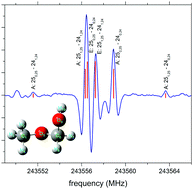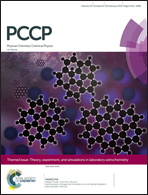Laboratory spectroscopy of methoxymethanol in the millimeter-wave range†
Abstract
Methoxymethanol, CH3OCH2OH is a very interesting candidate for detection in the interstellar medium since it can be formed in the recombination reaction between two radicals considered as intermediates in methanol formation: CH3O (already detected in the ISM) and CH2OH. It could also be formed by the addition of CH3O to formaldehyde (another abundant compound in the ISM) followed by abstraction of a hydrogen radical. In this study, we present the first spectroscopic characterization of methoxymethanol in the millimeter-wave range augmented by high level quantum chemical calculations. The analysis revealed three stable conformations all exhibiting different large amplitude motions (LAMs). For the analysis of the most stable conformation (I) we applied a model that accounts for hindered internal rotation of the methyl top. The analysis of conformation III was performed taking the interaction between the overall rotation and OH torsional motion into account. Conformation II was only tentatively assigned, as it exhibits several LAMs that significantly complicate the theoretical description. Accurate spectroscopic parameters obtained in this study provide a reliable basis for the detection of methoxymethanol in the ISM.

- This article is part of the themed collection: Theory, experiment, and simulations in laboratory astrochemistry


 Please wait while we load your content...
Please wait while we load your content...